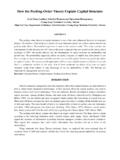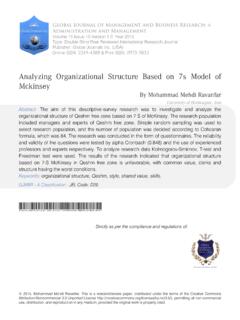Transcription of Funding Stormwater Programs - United States …
1 United States Environmental Protection Agency New England Funding Stormwater Programs EPA 901-F-09-004 Executive Summary This document is intended to assist local Stormwater managers to alleviate the significant expense of construction, operation and maintenance of a municipal separate storm sewer system (MS4). The costs of Stormwater Programs , increased by regulatory requirements ( Stormwater Phase I or Phase II), flooding concerns, water quality issues (including total maximum daily loads, or TMDLs) and population growth, may be subsidized through a Stormwater utility or various other methods detailed in this document.
2 Stormwater management can be costly, but it is a good investment. There are new Stormwater management techniques, referred to as low impact development (LID), that infiltrate, evapotranspire and reuse Stormwater , thereby, preventing polluted runoff from happening. This helps to reduce the high costs of cleaning up the water quality impairments from the polluted runoff. Additional benefits from these techniques include increased ground water recharge, flood control, and healthy aquatic ecosystems through maintenance of base flow for streams. LID techniques need to be sited and designed carefully, and used in conjunction with traditional Stormwater management techniques.
3 This fact sheet includes information on various Stormwater Funding mechanisms and types of Stormwater utilities; it also describes how to create a Stormwater utility and provides a list of resources. New England Case Studies More than 800 communities or districts across the country have adopted a Stormwater utility to help fund the costs of Stormwater Programs , including the costs of regulatory compliance, planning, maintenance, capital improvements, and repair or replacement of infrastructure. Examples of utilities from two New England cities are discussed below. South Burlington, Vermont The South Burlington Stormwater Utility is the first of its kind in Vermont.
4 Six streams in and around South Burlington are impaired from Stormwater , resulting in water pollution, erosion, flooding, and unstable streambanks. The utility was established in 2006 to help mitigate the increasingly complex issues associated with Stormwater management, including failing septic systems in older developments and phosphorus runoff polluting Lake Champlain, which is the primary source of drinking water for the Burlington area. April 2009 The municipal Stormwater Services Division administers the utility, which pays for system maintenance, capital project construction, enforcement, and customer outreach and assistance.
5 An example of a capital project construction (a gravel wetland) that was paid for by the Stormwater utility in South Burlington, Vermont. User fees are based on the amount of impervious area on a property. The monthly fee per equivalent residential unit (ERU) was set using a scientific process. This process determined that a typical single-family home in South Burlington had 2,700 square feet of impervious surface. A single-family home is assessed a fee of $ per month, whereas duplexes and triplexes are assessed fees of $ and $ per month, respectively. All other properties are assessed a fee depending on the amount of impervious surface.
6 The utility funds a comprehensive program bringing in more than $1 million annually. Cities in New England with Stormwater Utilities Chicopee, Massachusetts Lewiston, Maine Newton, Massachusetts Reading, Massachusetts South Burlington, Vermont (as of December 2008) EPA 901-F-09-004 Funding Stormwater Programs Newton, Massachusetts A Stormwater Drain Fee was established in 2006. The utility enables the city to manage and upgrade Stormwater infrastructure, protect nearby natural waterbodies ( , Charles River and Crystal Lake), provide technical assistance with Stormwater management issues, and provide educational Programs for residents and schools.
7 User fees are based on a flat rate. Residential properties are assessed a fee of $ per quarter, and all other properties are assessed a fee of $ per quarter. The Board of Aldermen debated using a different fee structure but found that the program s operating costs would triple if the city had to determine the rates on the basis of individual lot sizes. Two hydraulically connected bioretention cells paid for by the Stormwater utility on Hammond Pond in Newton, Massachusetts Stormwater Funding Mechanisms The most common Funding options for municipal Stormwater Programs are discussed below. Service Fees (including Stormwater utilities) Some communities include Stormwater management costs within their water or sanitary sewer system budgets, often basing fees on metered water flow.
8 However, a property s metered water flow usually bears no relationship to the Stormwater runoff it generates. For example, the Stormwater runoff from the impervious area of a shopping center s buildings and parking lots is significant, but its use of metered water is relatively small. Stormwater fees, which are typically based on property type or area, provide for regulatory compliance and operation andmaintenance costs, and are charged to both tax-paying and tax-exempt properties. The average quarterly fee for a single-family home is $11, though some communities chargeas little as $2 or as much as $40 per quarter to a single-family home.
9 Property Taxes/General Fund Many communities fund Stormwater management through property taxes paid into their general funds, but in the competition for general fund dollars, Stormwater management improvements are typically considered low priority unless the municipality is reacting to a recent major storm or regulatory action. This system is also not equitable, because the basis for determining property taxes, assessed property value, is irrelevant to the cost of Stormwater management for that property. Additionally, tax-exempt properties, such as governmental properties, schools, colleges, and universities, do not support any of the cost of Stormwater management, even though many of them are major contributors of Stormwater runoff.
10 Special Assessment Districts or Regional Funding Mechanisms If a Stormwater construction project benefits only a portion of a municipality, it can be funded by fees assessed only to those properties within that area, which is called a special assessment district. Separate Stormwater utility districts can also be formed within a town or by bringing several towns together to form a district. There might be some cases where regional or multiple-jurisdictional Funding mechanisms would be useful. For example, if an impaired stream has a fairly small watershed, spanning parts of several municipalities, costs of Stormwater implementation could be shared among the municipalities and the Funding could be managed by an existing regional authority such as a soil and water conservation district.















